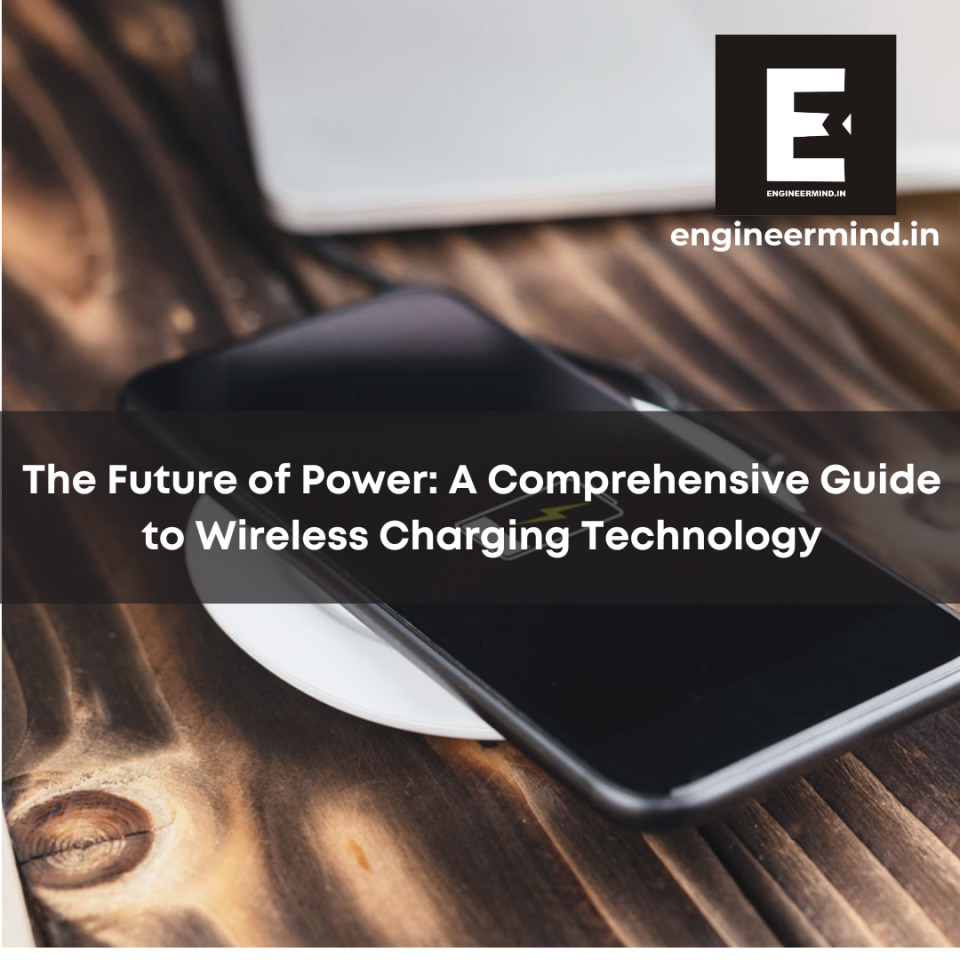
In recent years, wireless charging technology has gained immense popularity as a convenient and efficient way to power up our devices. With more and more devices adopting this technology, it’s no surprise that wireless charger has become a hot topic in the tech world. In this article, we’ll explore what is wireless charging technology, how it works, its benefits and its future.
Table of Contents
What is Wireless Charging Technology?
Wireless charging technology is based on the principle of electromagnetic induction. The charging pad or mat contains a coil of wire that generates an electromagnetic field when it’s connected to a power source. The device being charged must have a compatible wireless charging receiver that is typically located on the back of the device. When the device is placed on the pad, the electromagnetic field generated by the charging pad generates a small electrical current in the device’s receiver coil. This current is then used to charge the device’s battery.
One of the key advantages of wireless charging technology is that it eliminates the need for cables and connectors, making it a more convenient and hassle-free charging method. It also offers a higher degree of flexibility, as devices can be charged simply by being placed on a charging pad or mat.
Wireless charging technology is also generally more energy-efficient than traditional charging methods, resulting in less energy waste and more sustainable energy usage. In addition, wireless charging is generally safer than traditional charging methods, as there are no exposed wires or charging ports that can be damaged or pose a risk of electrocution or electric shock.
How Does Wireless Charging Work?
Wireless charging technology, also known as inductive charging, works by using an electromagnetic field to transfer energy between two objects – a charging pad or mat, and a device being charged. Here’s how it works in more detail:
- The charging pad or mat contains a coil of wire that is connected to a power source. When the power source is turned on, the coil generates an electromagnetic field.
- The device being charged must have a compatible wireless charging receiver. This receiver typically consists of another coil of wire, located on the back of the device.
- When the device is placed on the charging pad or mat, the electromagnetic field generated by the pad induces a small electrical current in the receiver coil on the device.
- This electrical current is then converted by the receiver into a direct current (DC) that can be used to charge the device’s battery.
- Once the device’s battery is fully charged, the charging process automatically stops.
It’s worth noting that there are different types of wireless charging technology, including Qi, PMA, and A4WP, which have slightly different technical specifications. However, the basic principle of electromagnetic induction is the same across all types of wireless charging technology.
Benefits of Wireless Charging Technology
Wireless charging technology offers a range of benefits over traditional wired charging methods. Here are some of the most significant advantages:
1. Convenience
Wireless charging eliminates the need for cables and connectors, making it a more convenient and hassle-free charging method.
One of the primary benefits of wireless charging technology is convenience. With traditional wired charging methods, users have to physically connect their device to a charging cable and then plug the cable into a power source. This can be cumbersome and inconvenient, especially when dealing with multiple devices or when on the go.
Wireless charging eliminates the need for cables and connectors, allowing users to simply place their device on a charging pad or mat to begin charging. This means no more fumbling with cables or worrying about whether the device is properly plugged in. Users can simply place their devices on the charging pad and go about their day.
In addition, wireless charging pads can be placed in convenient locations throughout a home or office, allowing users to easily charge their devices without having to hunt for a power outlet. For example, a wireless charging pad could be placed on a nightstand, allowing users to charge their phones overnight without having to fumble for a charging cable.
Wireless charging also offers a higher degree of flexibility. With traditional wired charging, the device must be located near a power source, which can limit where and when it can be charged. With wireless charging, devices can be charged virtually anywhere there is a charging pad or mat.
Overall, the convenience offered by wireless charging technology has made it a popular choice among consumers and has helped to drive its widespread adoption across a range of devices.
2. Efficiency
Wireless charging can be more energy-efficient than traditional charging methods, resulting in less energy waste and more sustainable energy usage.
Wireless charging technology is generally more energy-efficient than traditional wired charging methods, resulting in less energy waste and more sustainable energy usage. Here’s why:
- Reduced energy loss
With wired charging, a significant amount of energy is lost as heat due to the resistance of the charging cable. In contrast, wireless charging eliminates this energy loss, resulting in a more efficient charging process.
- Smart charging
Many wireless charging devices are equipped with smart charging technology that regulates the charging process to prevent overcharging, which can waste energy and potentially damage the battery. By optimizing the charging process, wireless charging devices can use energy more efficiently.
- Standby mode
Some wireless charging devices are designed to automatically switch to standby mode when a device is fully charged. This prevents unnecessary energy consumption and ensures that the charging process stops when it’s no longer needed.
- Sustainable energy usage
By using wireless charging, users can reduce their reliance on traditional power sources, such as wall outlets or USB ports, which are often powered by non-renewable sources of energy. This can help to reduce overall energy consumption and promote more sustainable energy usage.
Overall, the increased energy efficiency offered by wireless charging technology can help to reduce energy waste and promote more sustainable energy usage. This is particularly important as the demand for energy continues to grow and concerns about climate change continue to mount.
3. Safety
With no exposed wires or charging ports, wireless charging is safer than traditional charging methods, reducing the risk of electrocution or electric shock.
Wireless charging technology is generally considered safe, but it’s important to be aware of potential safety concerns and precautions. Here are some key safety considerations related to wireless charging technology:
- Heat
Wireless charging can generate heat, particularly during prolonged use or if the device being charged is not properly aligned with the charging pad. This heat can potentially damage the device’s battery or even cause a fire. It’s important to follow the manufacturer’s instructions and avoid using damaged or improperly designed charging pads.
- Electromagnetic fields
Wireless charging uses electromagnetic fields to transfer energy between the charging pad and the device being charged. While the levels of electromagnetic radiation generated by wireless charging are typically low, some studies have suggested that prolonged exposure to these fields could potentially have health implications. However, the overall safety of wireless charging has been extensively studied and is generally considered to be safe for everyday use.
- Interference
Some wireless charging devices can interfere with other electronic devices, particularly medical devices such as pacemakers or hearing aids. It’s important to follow the manufacturer’s instructions and avoid using wireless charging devices near these types of medical devices.
- Foreign object detection:
Some wireless charging devices are equipped with foreign object detection technology that can detect when a foreign object is placed on the charging pad, such as keys or coins. This is important because placing a conductive object on the charging pad can cause a short circuit and potentially damage the device being charged.
Overall, wireless charging technology is generally considered safe for everyday use. However, it’s important to be aware of potential safety concerns and follow the manufacturer’s instructions to ensure the safe and proper use of the charging device.
4. Versatility
Wireless charging technology can be used in a variety of devices, including smartphones, smartwatches, and other electronic devices.
Wireless charging technology is versatile and can be used with a wide range of devices, from smartphones and tablets to wearables and even some larger devices like laptops. This versatility makes wireless charging a convenient option for users who have multiple devices with different charging requirements.
Here are some examples of the versatility of wireless charging technology:
- Smartphone charging
Wireless charging has become a standard feature on many newer smartphone models. By using a wireless charging pad or stand, users can easily charge their phones without the need for a charging cable. Many wireless charging pads can also charge multiple devices at once, making it convenient for households with multiple smartphones.
- Wearable charging
Many smartwatches, fitness trackers, and other wearable devices are also compatible with wireless charging technology. This makes it easy to keep these devices charged and ready to use without the hassle of cables and cords.
- Audio device charging
Wireless charging can also be used to charge wireless earbuds, headphones, and other audio devices. This is particularly convenient for users who frequently use these types of devices and want to keep them charged and ready to use at all times.
- Laptop charging
While not yet as common as a smartphone or wearable charging, wireless charging is starting to be integrated into some laptop models. This allows users to charge their laptops without the need for a traditional charging cable.
Overall, the versatility of wireless charging technology makes it a convenient option for users who have multiple devices with different charging requirements. By using a wireless charging pad or stand, users can keep all of their devices charged and ready to use without the hassle of cables and cords.
The Future of Wireless Charging
As the demand for wireless charging technology continues to grow, we can expect to see even more advancements in the near future. Some of the most exciting developments include:
- Longer Range Wireless Charging
New technologies are being developed to allow wireless charging at greater distances, allowing for more flexibility in where charging pads can be placed.
- Faster Charging
Researchers are working on developing wireless charging methods that can charge devices at much faster speeds than currently possible, reducing charging times significantly.
- Integration into Everyday Objects
With the rise of the Internet of Things (IoT), we can expect to see wireless charging technology integrated into a variety of everyday objects, including furniture, appliances, and even vehicles.
Conclusion
Wireless charging technology is a game-changer in the world of power, offering a more convenient, efficient, and safer way to charge our devices. With the continued development of new and innovative wireless charging technologies, we can expect to see even more benefits and potential applications in the future. It’s an exciting time to be alive, and wireless charging technology is undoubtedly playing a significant role in shaping our world.








